The Natural History Museum (NHM), London, has announced the winning images for the Wildlife Photographer of the Year 2021 competition. From more than 50,000 entries from 95 countries, the image of camouflage groupers in French Polynesia by French underwater photographer and biologist Laurent Ballesta was awarded the top prize.
His photo, titled ‘Creation’, captures the groupers leaving a milky cloud of their eggs and sperm. Ballesta had photographed this event every year for five years on the few nights that it occurs around the full moon in July.
“The image works on so many levels. It is surprising, energetic, and intriguing and has an otherworldly beauty,” says Rosamund ‘Roz’ Kidman Cox OBE, chair of the judging panel, writer and editor. “It also captures a magical moment – a truly explosive creation of life – leaving the tail-end of the exodus of eggs hanging for a moment like a symbolic question mark.”
“This year’s Grand Title winner reveals a hidden underwater world, a fleeting moment of fascinating animal behaviour that very few have witnessed,” says Dr Doug Gurr, director of the NHM. “In what could be a pivotal year for the planet, with vital discussions taking place at COP15 and COP26, Laurent Ballesta’s Creation is a compelling reminder of what we stand to lose if we do not address humanity's impact on our planet. The protection provided to this endangered species by the biosphere reserve highlights the positive difference we can make.”
The title of Young Wildlife Photographer of the Year was awarded to Vidyun R Hebbar for his ‘Dome home’ image of a tent spider.
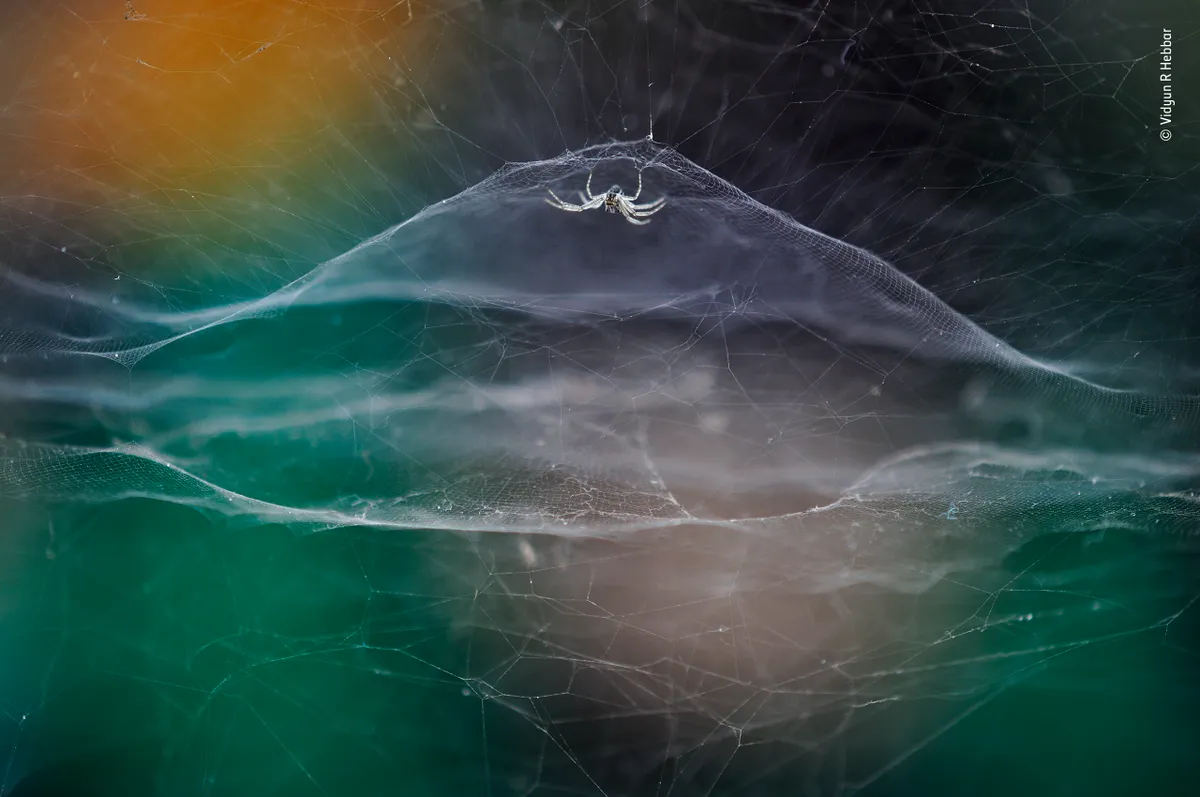
“It’s such an imaginative way of photographing a spider. The picture is perfectly framed, the focus is spot on. You can see the spider’s fangs and the crazy weave of the trap, the threads like some delicate nerve network linked to the spider’s feet. But the really clever bit is the addition of a creative backdrop – the bright colours of a motorised rickshaw,” says Cox.
View the Winning and Highly Commended images from recent years:
The winning images were revealed on 12 October 2021 in an online Awards show broadcast from the NHM and hosted by conservationists and presenters Chris Packham and Megan McCubbin.
Pick up a copy of the November 2021 issue of BBC Wildlife Magazine, on sale from Thursday 21 October, for a 32-page supplement featuring the winning images.
Wildlife Photographer of the Year is developed and produced by the NHM, London. The exhibition opens on Friday 15 October 2021 at the museum, before embarking on a UK and international tour.
The fifty-eighth Wildlife Photographer of the Year competition will open for entries on Monday 18 October 2021 and close at 11.30am GMT on Thursday 9 December 2021.
To view the images as a slideshow, click on the arrows in the top right hand corner of the photos below.
Underwater, and Overall Wildlife Photographer of the Year
Creation, by Laurent Ballesta (France)
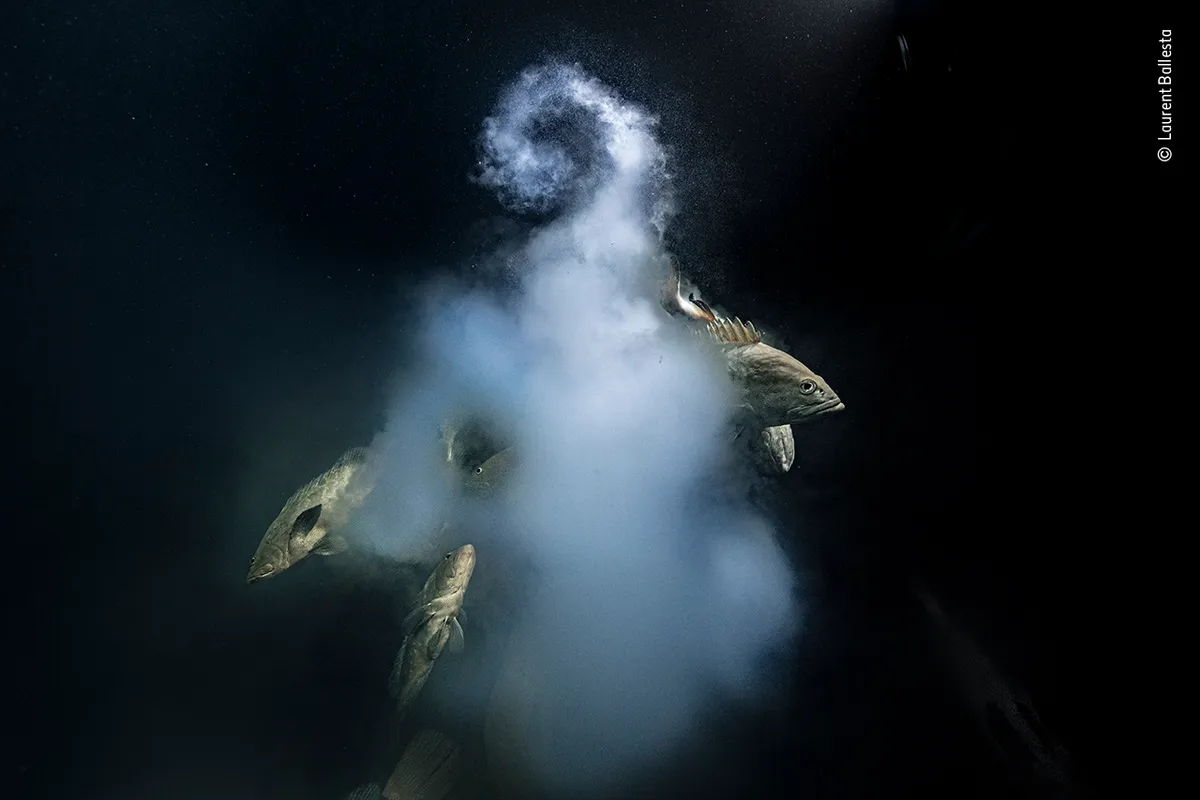
Laurent Ballesta (France) peers into the depths as a trio of camouflage groupers exit their milky cloud of eggs and sperm.
For five years Laurent and his team returned to this lagoon, diving day and night to see the annual spawning of camouflage groupers. They were joined after dark by reef sharks hunting the fish.
Spawning happens around the full moon in July, when up to 20,000 fish gather in Fakarava in a narrow southern channel linking the lagoon with the ocean. Overfishing threatens this species, but here the fish are protected within a biosphere reserve.
Nikon D5 + 17–35mm f2.8 lens at 17mm 1/200 sec at f11 ISO 1600 Seacam housing Seacam strobes1/200 sec at f11 ISO 1600 Seacam housing Seacam strobes.
Animals in their Environment
Grizzly leftovers, by Zack Clothier (USA)
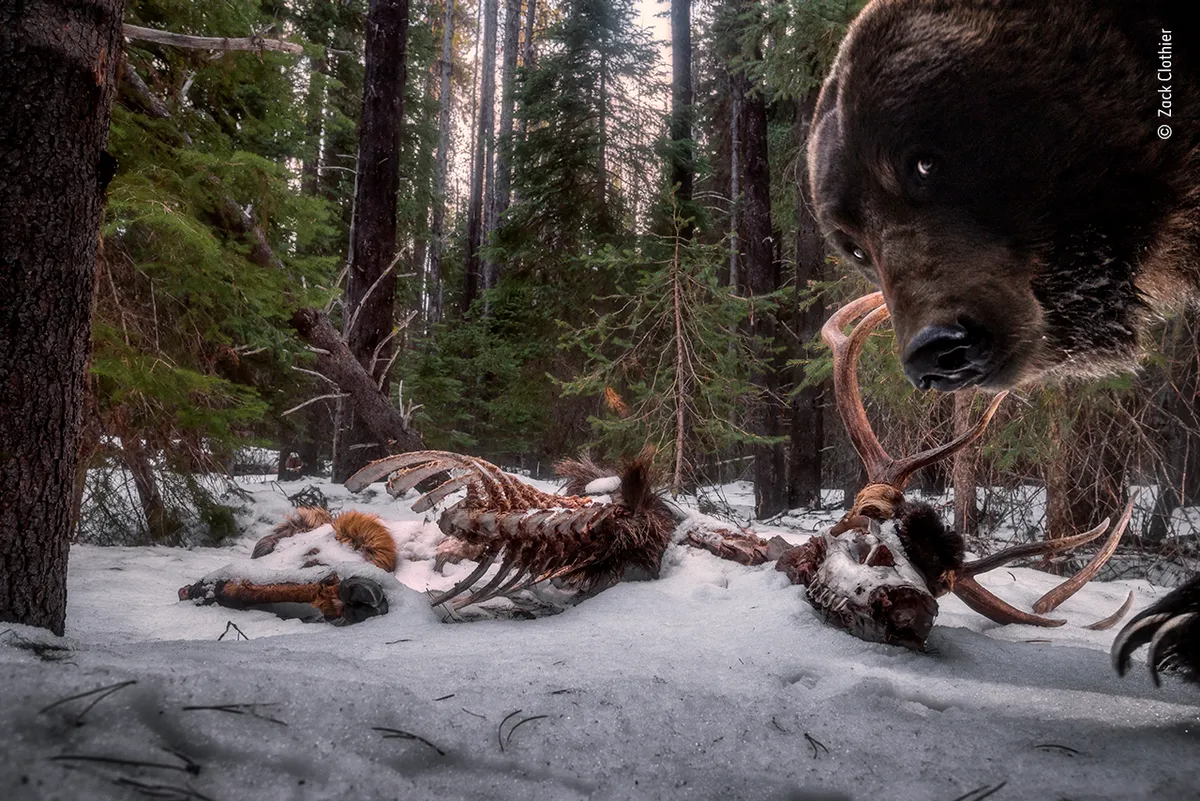
Zack Clothier (USA) discovers a grizzly bear has taken an interest in his camera trap.
Zack decided these bull elk remains were an ideal spot to set a camera trap. Returning to the scene was challenging. Zack bridged gushing meltwater with fallen trees, only to find his setup trashed. This was the last frame captured on the camera.
Grizzlies, a subspecies of brown bears, spend up to seven months in torpor – a light form of hibernation. Emerging in spring, they are hungry and consume a wide variety of food, including mammals.
Nikon D610 + 18–35mm f3.5–4.5 lens at 25mm 1/160 sec at f10 (-1.7 e/v) ISO 1000 two Nikon SB-28 flashes self-made camera-trap system.
Animal Portraits
Reflection, by Majed Ali (Kuwait)
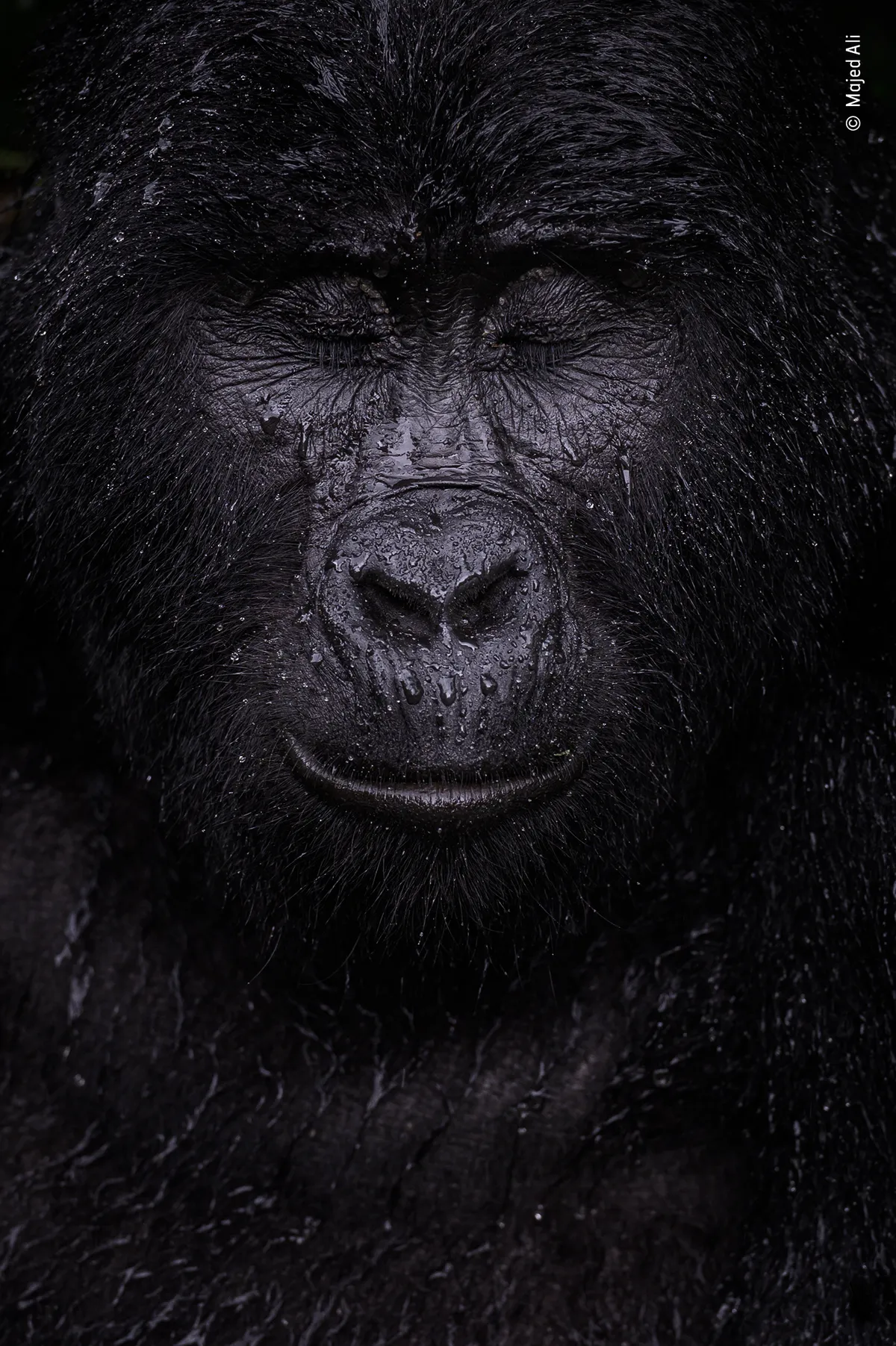
Majed Ali (Kuwait) glimpses the moment a mountain gorilla closes its eyes in the rain.
Majed trekked for four hours to meet Kibande, an almost-40- year-old mountain gorilla. ‘The more we climbed, the hotter and more humid it got,’ Majed recalls. As cooling rain began to fall, Kibande remained in the open, seeming to enjoy the shower.
Mountain gorillas are a subspecies of the eastern gorilla, and are found at altitudes over 1,400 metres in two isolated populations – at the Virunga volcanoes and in Bwindi. These gorillas are endangered due to habitat loss, disease, poaching and habitat disruption caused by human activity.
Nikon Z6 + 70–200mm f2.8 lens at 200mm 1/320 sec at f6.3 ISO 640.
Behaviour: Birds
The intimate touch, by Shane Kalyn (Canada)
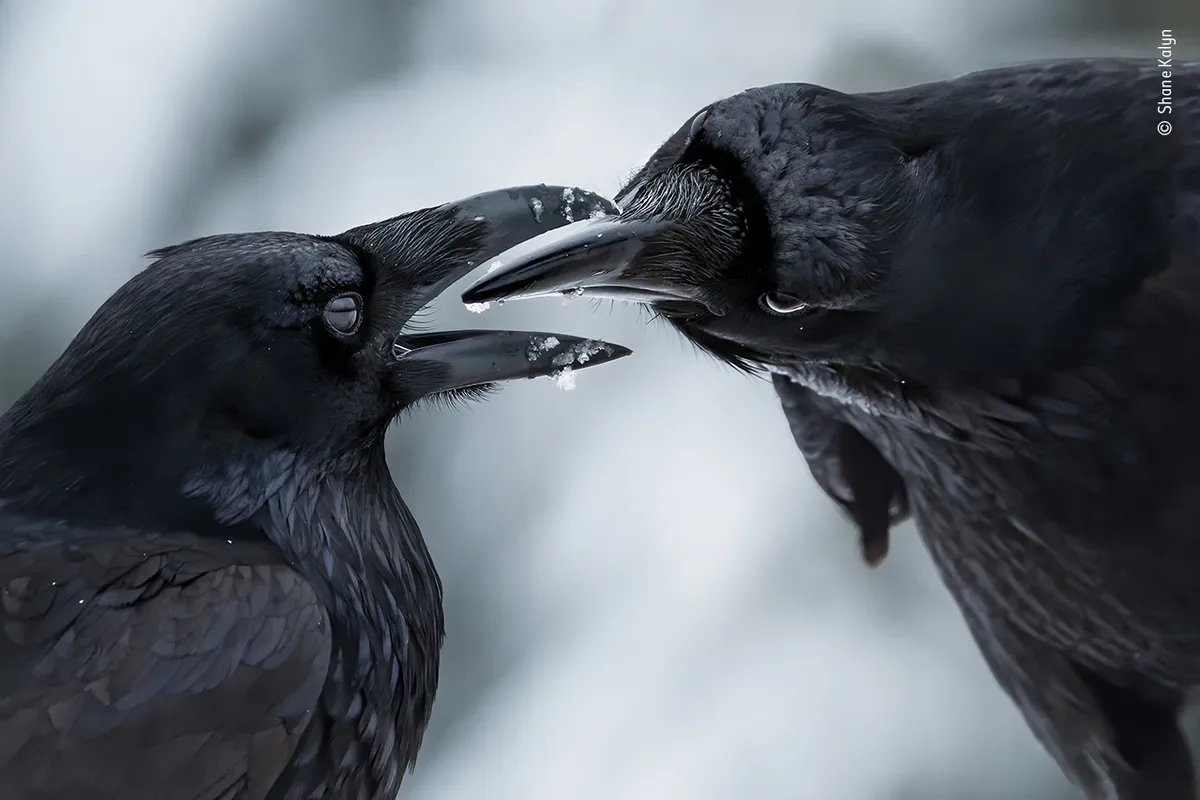
Shane Kalyn (Canada) watches a raven courtship display.
It was midwinter, the start of the ravens’ breeding season. Shane lay on the frozen ground using the muted light to capture the detail of the ravens’ iridescent plumage against the contrasting snow to reveal this intimate moment when their thick black bills came together.
Ravens probably mate for life. This couple exchanged gifts – moss, twigs and small stones – and preened and serenaded each other with soft warbling sounds to strengthen their relationship or ‘pair bond’.
Nikon D500 + 200–500mm f5.6 lens at 420mm 1/1250 sec at f7.1 ISO 900.
Behaviour: Mammals
Head to head, by Stefano Unterthiner (Italy)
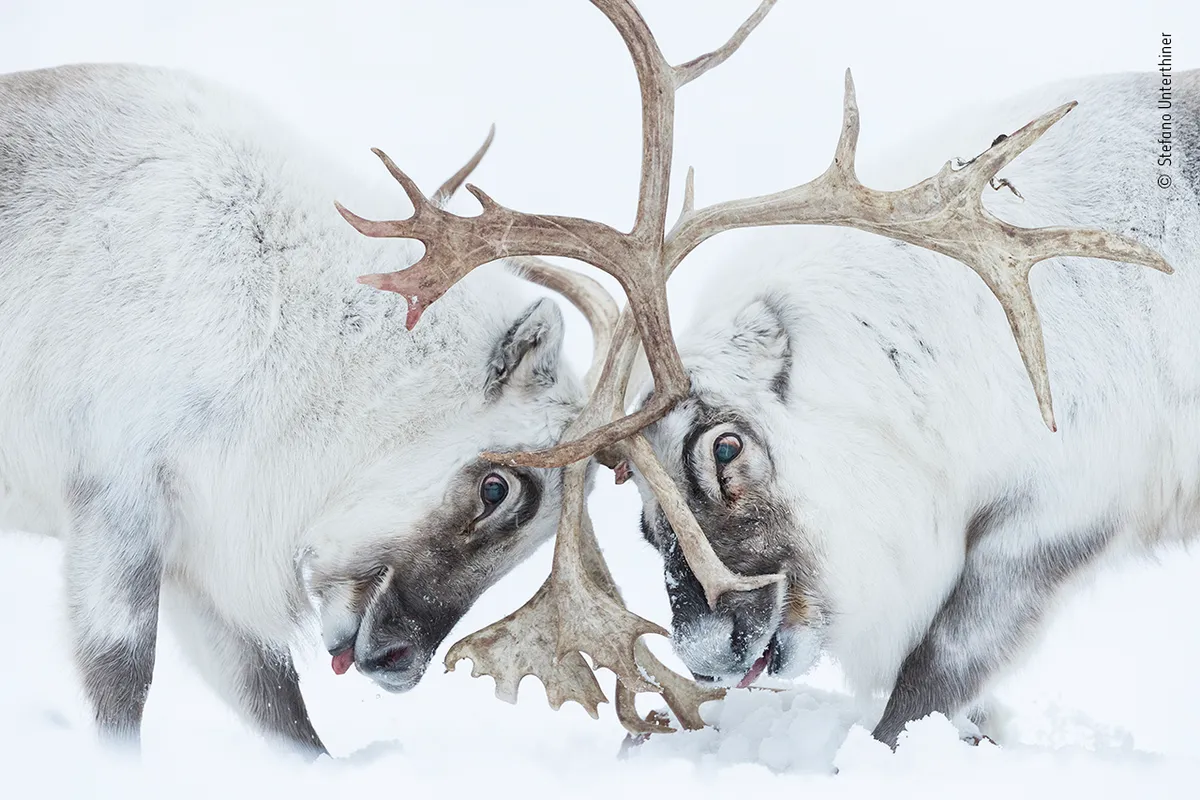
Stefano Unterthiner (Italy) watches two Svalbard reindeer battle for control of a harem.
Stefano followed these reindeer during the rutting season. Watching the fight, he felt immersed in ‘the smell, the noise, the fatigue and the pain’. The reindeer clashed antlers until the dominant male (left) chased its rival away, securing the opportunity to breed.
Reindeer are widespread around the Arctic, but this subspecies occurs only in Svalbard. Populations are affected by climate change, where increased rainfall can freeze on the ground, preventing access to plants that would otherwise sit under soft snow.
Nikon D5 + 180–400mm f4 lens at 400mm 1/640 sec at f4 ISO 3200.
Behaviour: Amphibians and Reptiles
Where the giant newts breed, by João Rodrigues (Portugal)
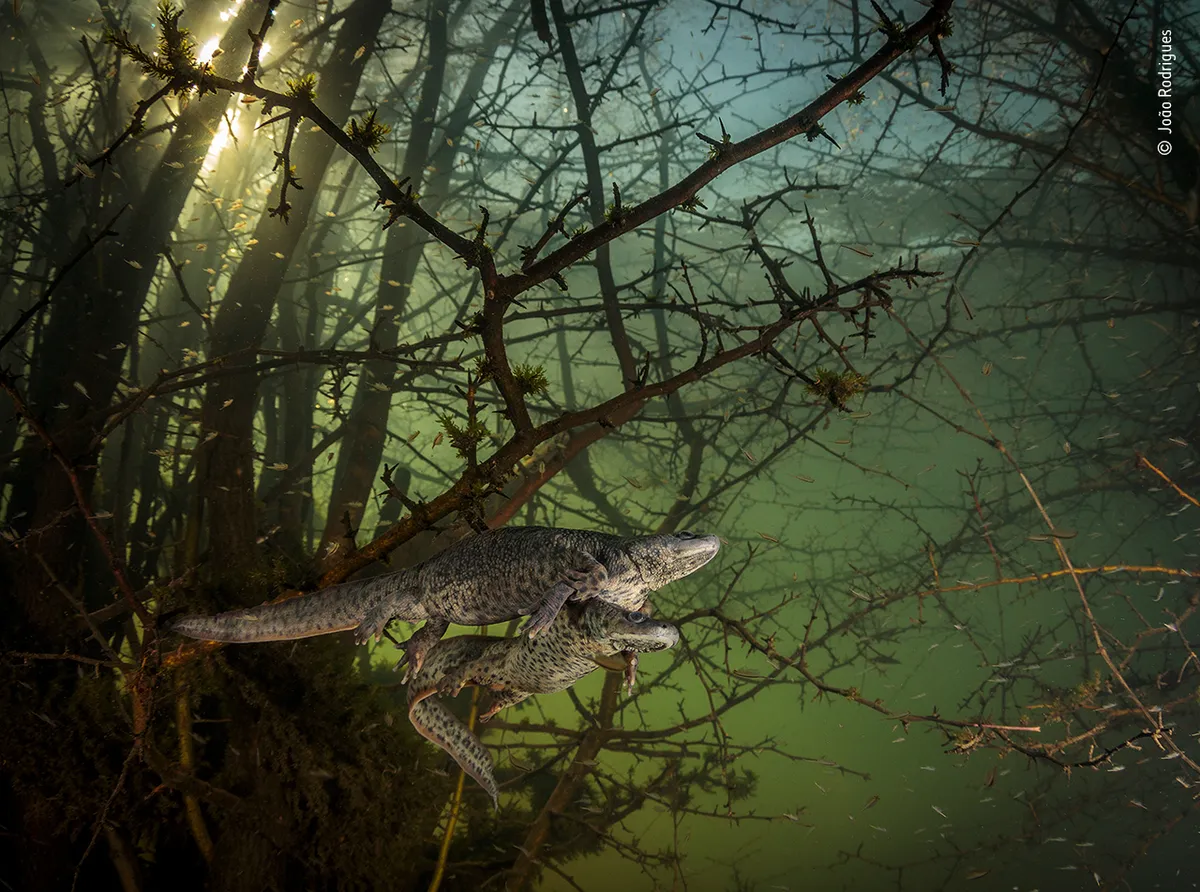
João Rodrigues (Portugal) is surprised by a pair of courting sharp-ribbed salamanders in the flooded forest.
It was João’s first chance in five years to dive in this lake as it only emerges in winters of exceptionally heavy rainfall, when underground rivers overflow. He had a split second to adjust his camera settings before the newts swam away.
Found on the Iberian Peninsula and in northern Morocco, sharp-ribbed newts (or salamanders) are named after their defence strategy. They use their pointed ribs as weapons, piercing through their own skin and picking up poisonous secretions, then jabbing them into an attacker.
Canon EOS 5D Mark IV + Tokina 10–17mm f3.5–4.5 lens at 16mm 1/200 sec at f13 ISO 320 Aquatica housing two INON Z-330 flashes.
Natural Artistry
Bedazzled, by Alex Mustard (UK)
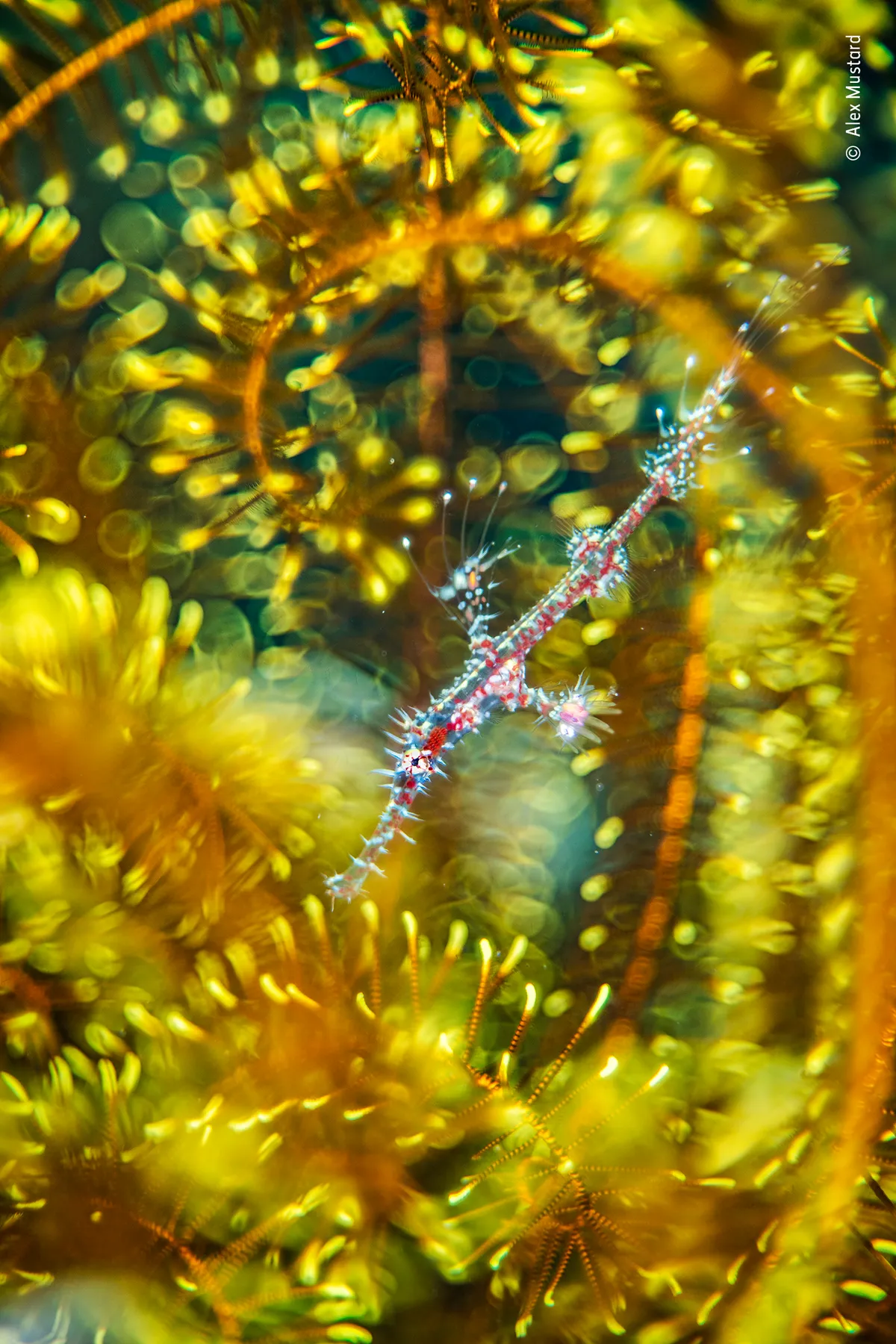
Alex Mustard (UK) finds a ghost pipefish hiding among the arms of a feather star.
Alex had always wanted to capture this image of a juvenile ghost pipefish but usually only found darker adults on matching feather stars. His image conveys the confusion a predator would likely face when encountering this kaleidoscope of colour and pattern.
The juvenile’s loud colours signify that it landed on the coral reef in the past 24 hours. In a day or two, its colour pattern will change, enabling it to blend in with the feather star.
Nikon D850 + Trioplan 100mm f2.8 lens 12mm extension tube ND8 filter FIT +5 close-up lens 1/250 sec at f2.8 ISO 80 Subal housing two Retra strobes.
Oceans: The Bigger Picture
Nursery meltdown, by Jennifer Hayes (USA)
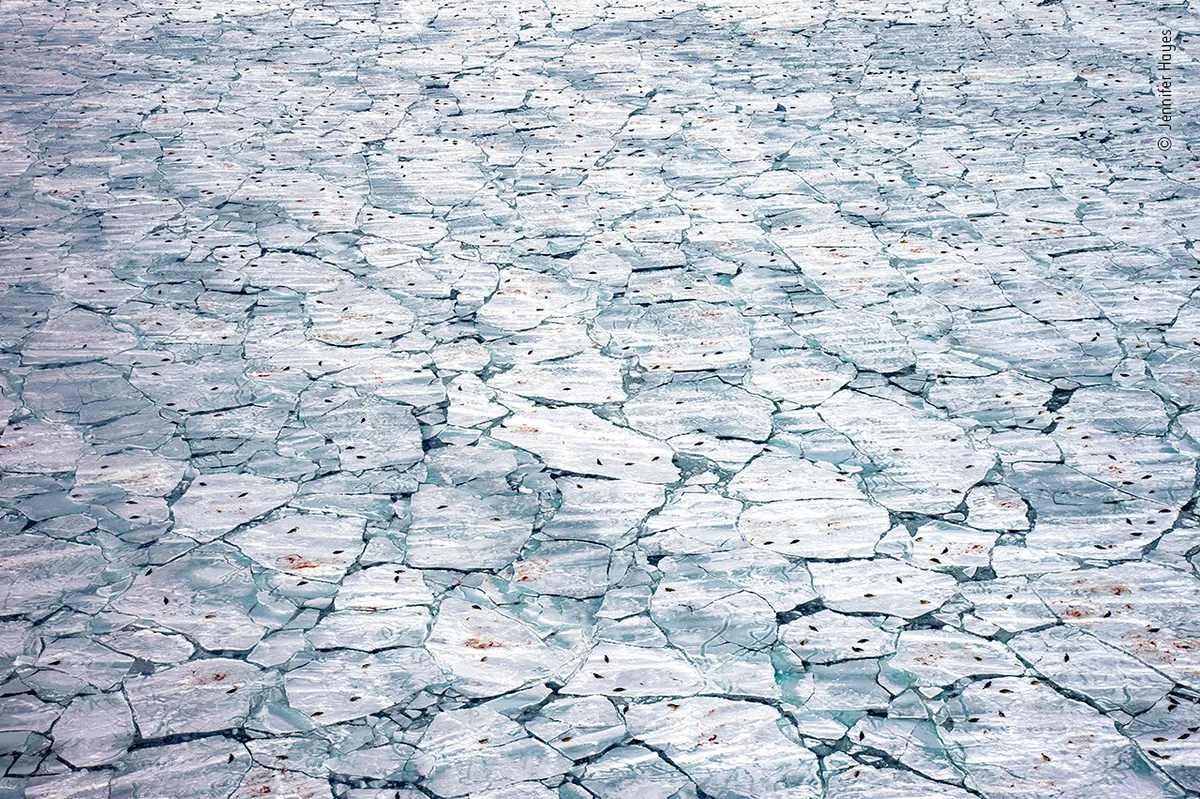
Jennifer Hayes (USA) records harp seals, seal pups and the blood of birth against melting sea ice.
Following a storm, it took hours of searching by helicopter to find this fractured sea ice used as a birthing platform by harp seals. ‘It was a pulse of life that took your breath away,’ says Jennifer.
Every autumn, harp seals migrate south from the Arctic to their breeding grounds, delaying births until the sea ice forms. Seals depend on the ice, which means that future population numbers are likely to be affected by climate change.
Nikon D4 + 24–120mm f4 lens 1/640 sec at f9 ISO 200.
Plants and Fungi
Rich reflections, by Justin Gilligan (Australia)
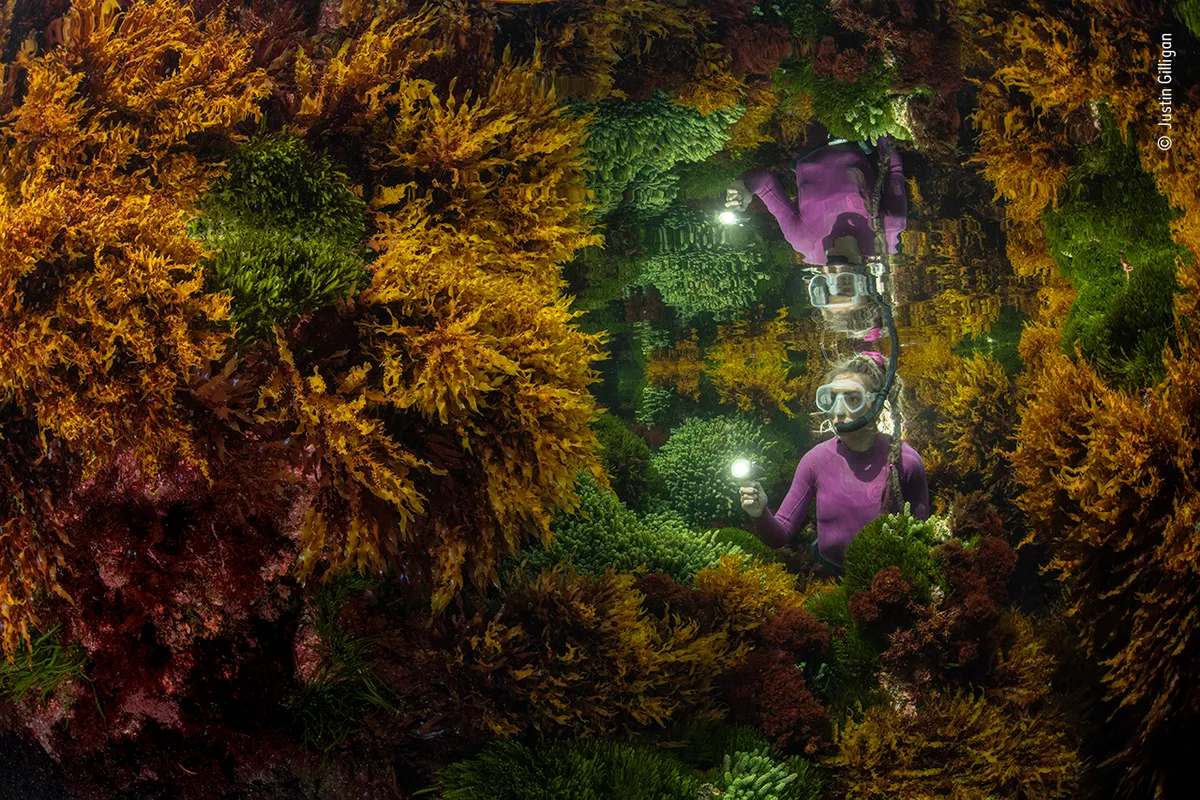
Justin Gilligan (Australia) creates the reflection of a marine ranger among the seaweed.
At the world’s southernmost tropical reef, Justin wanted to show how careful human management helps preserve this vibrant seaweed jungle. With only a 40-minute window where tide conditions were right, it took three days of trial and error before Justin got his image.
Impacts of climate change, such as increasing water temperature, are affecting the reefs at an ever-increasing rate. Seaweed forests support hundreds of species, capture carbon, produce oxygen and help protect shorelines.
Nikon D850 + Sigma 15mm f2.8 lens 1/160 sec at f13 ISO 400 Nauticam housing twin Ikelite DS161 strobes + sync cord.
Urban Wildlife
The spider room, by Gil Wizen (Israel/Canada)
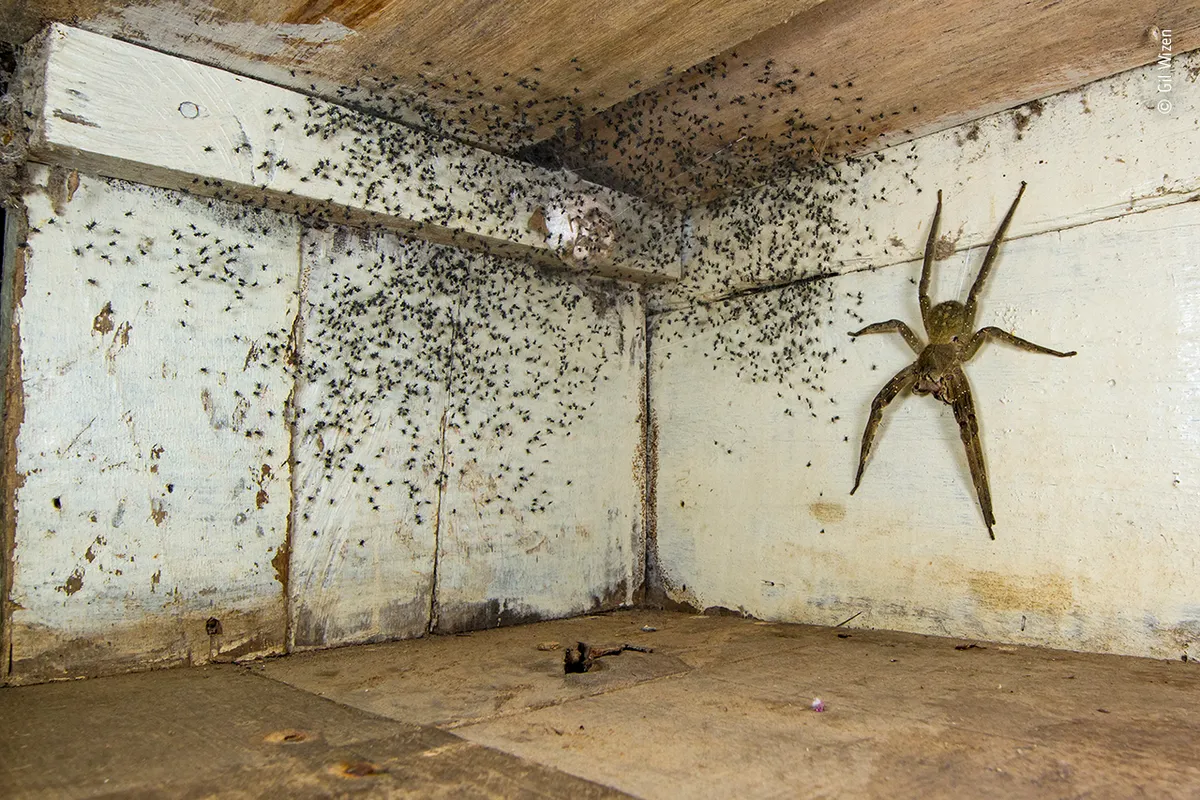
Gil Wizen (Israel/Canada) finds a venomous Brazilian wandering spider hiding under his bed.
After noticing tiny spiders all over his bedroom, Gil looked under his bed. There, guarding its brood, was one of the world’s most venomous spiders. Before safely relocating it outdoors, he photographed the human-hand-sized Brazilian wandering spider using forced perspective to make it appear even larger.
Brazilian wandering spiders roam forest floors at night in search of prey such as frogs and cockroaches. Their toxic venom can be deadly to mammals including humans, but it also has medicinal uses.
Canon EOS 7D + 14mm f2.8 lens 1/250 sec at f11 ISO 400 Macro Twin Lite flash.
Photojournalism
Elephant in the room, by Adam Oswell (Australia)
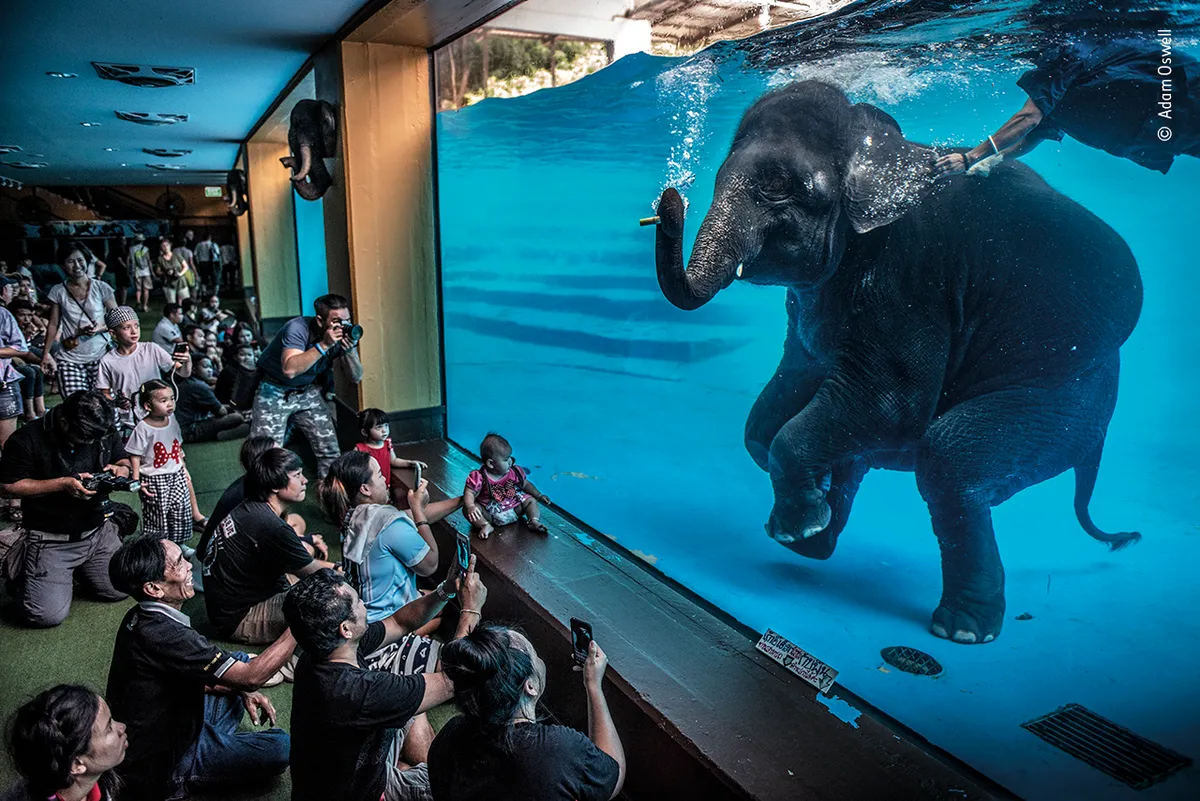
Adam Oswell (Australia) draws attention to zoo visitors watching a young elephant perform under water.
Although this performance was promoted as educational and as exercise for the elephants, Adam was disturbed by this scene. Organisations concerned with the welfare of captive elephants view performances like these as exploitative because they encourage unnatural behaviour.
Elephant tourism has increased across Asia. In Thailand there are now more elephants in captivity than in the wild. The Covid-19 pandemic caused international tourism to collapse, leading to elephant sanctuaries becoming overwhelmed with animals that can no longer be looked after by their owners.
Nikon D810 + 24–70mm lens 1/640 sec at f2.8 ISO 1250.
Photojournalist Story Award
The healing touch, from Community care, by Brent Stirton (South Africa)
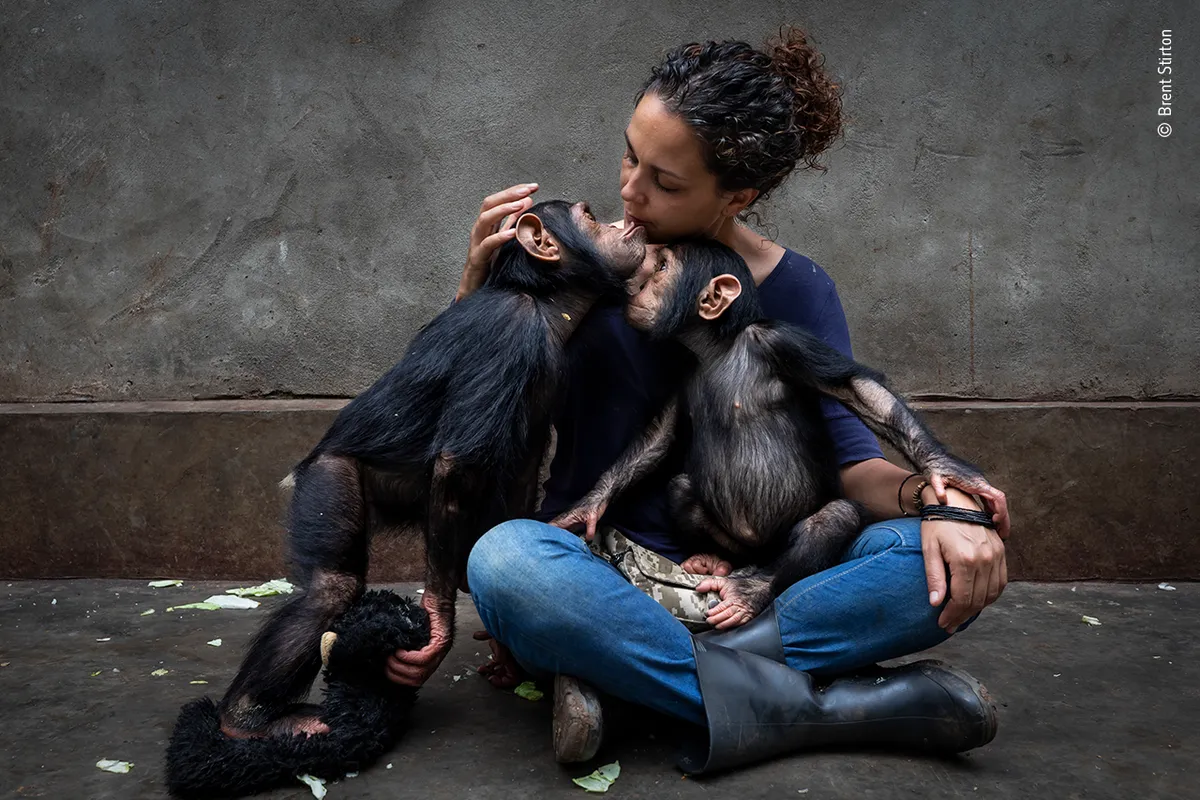
Brent Stirton (South Africa) profiles a rehabilitation centre caring for chimpanzees orphaned by the bushmeat trade.
The director of the centre sits with a newly rescued chimp as she slowly introduces it to the others. Young chimps are given one-to-one care to ease their psychological and physical trauma. These chimps are lucky. Less than one in ten are rescued after having seen the adults in their group killed for meat. Most have experienced starvation and suffering.
Technical details: Canon EOS 5D Mark IV + 16–35mm lens; 1/250 sec at f5.6; ISO 400.
Portfolio Story:
Many people around the globe rely on meat from wild animals – bush meat – for protein, as well as a source of income. Hunting endangered species such as chimpanzees is illegal but takes place all too frequently. Brent’s photographs document the work of the Lwiro Primate Rehabilitation Center, which rescues and rehabilitates primates orphaned by poaching. Many staff here are survivors of military conflict in the Democratic Republic of the Congo. Working at the centre helps with their own recovery.
15-17 years
High-flying jay, by Lasse Kurkela (Finland)
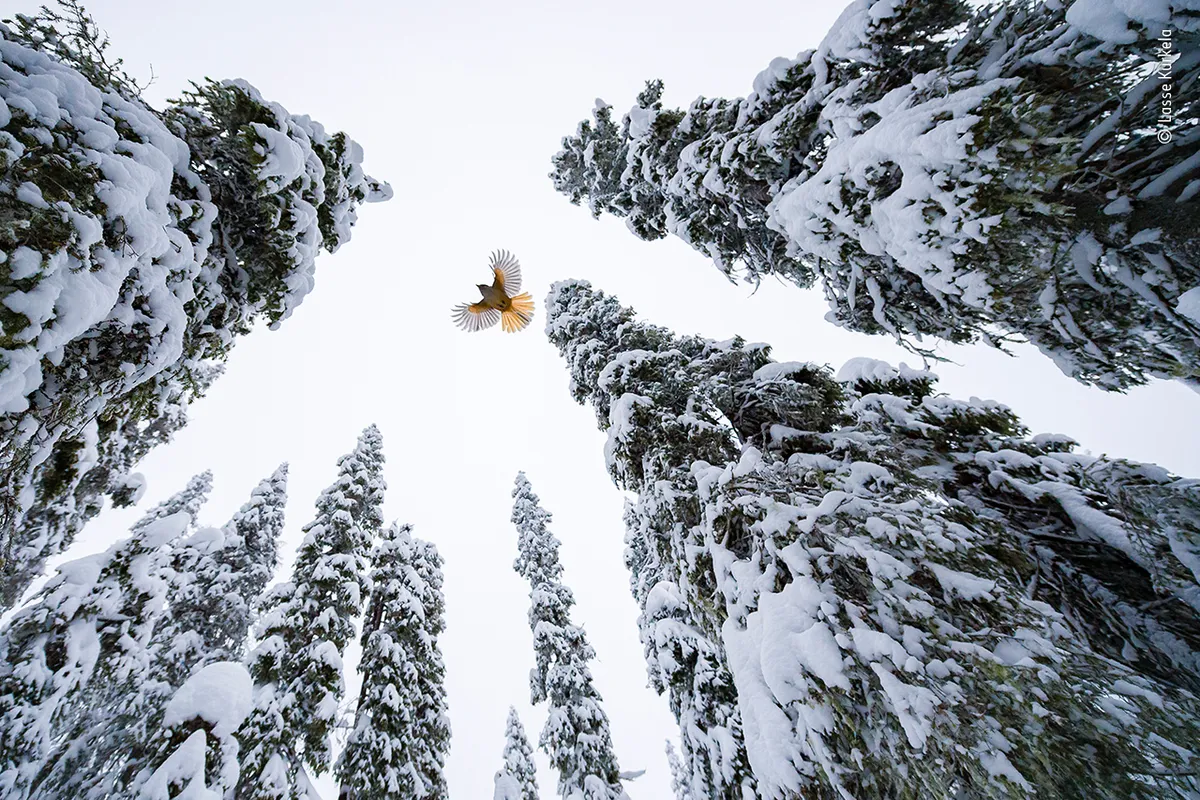
Lasse Kurkela (Finland) watches a Siberian jay fly to the top of a spruce tree to stash its food.
Lasse wanted to give a sense of scale in his photograph of the Siberian jay, tiny among the old-growth spruce-dominated forest. He used pieces of cheese to get the jays accustomed to his remotely controlled camera and to encourage them along a particular flight path.
Siberian jays use old trees as larders. Their sticky saliva helps them glue food such as seeds, berries, small rodents and insects high up in the holes and crevices of the bark and among hanging lichens.
Nikon D5 + 14–24mm f2.8 lens 1/800 sec at f4 (+0.7 e/v) ISO 6400 Vello remote control.
11-14 years
Sunflower songbird, by Andrés Luis Dominguez Blanco (Spain)
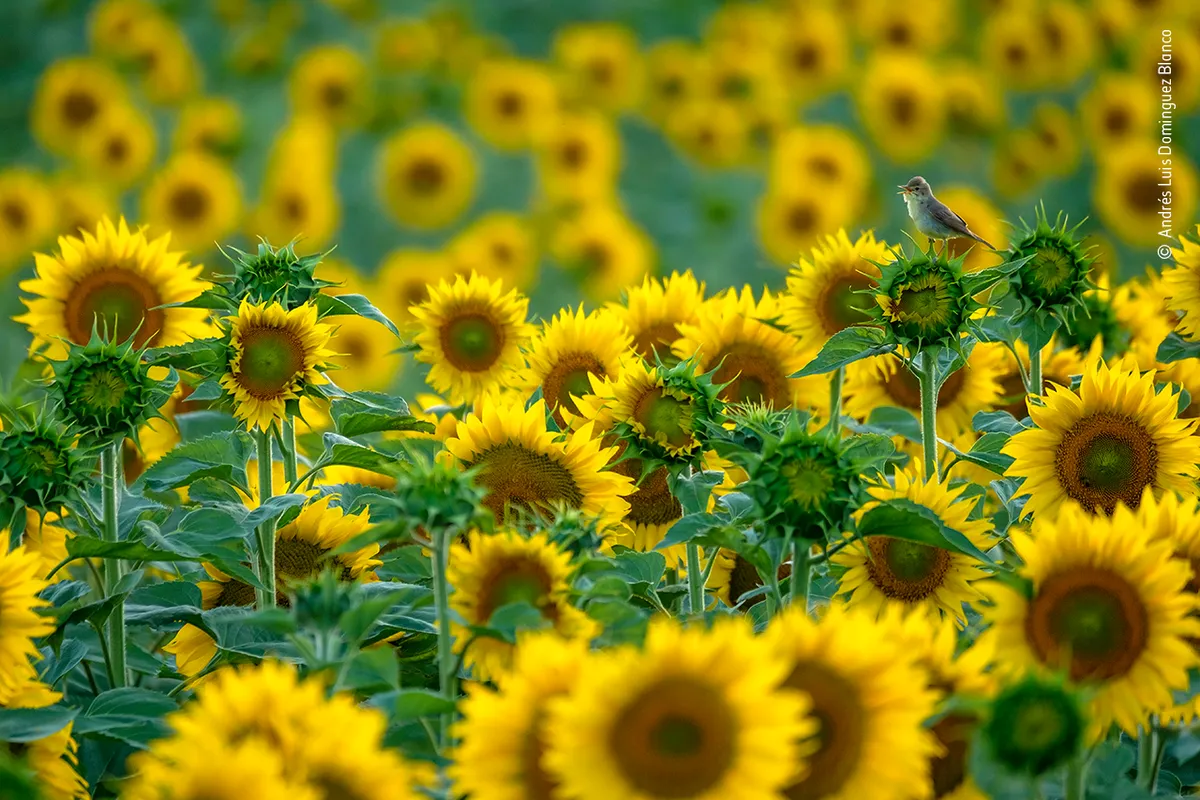
Andrés Luis Dominguez Blanco (Spain) enjoys the splendour of the sunflowers and a melodious warbler singing its heart out.
As light faded at the end of a warm May afternoon, Andrés’s attention was drawn to a warbler flitting from flower to flower. From his hide in his father’s car, Andrés photographed the singer, ‘the king of its territory’.
Melodious warblers are one of more than 400 species of songbird known as Old World warblers, which each have a distinctive song. The song of a melodious warbler is a pleasant babbling and without the mimicked sounds that other warblers sometimes make.
Fuji X-H1 + XF 100–400mm f4.5–5.6 lens 1/280 sec at f5.6 (-1 e/v) ISO 400.
10 years and under
Dome home, by Vidyun R Hebbar (India)

Vidyun R Hebbar (India) watches a tent spider as a tuk-tuk passes by.
Exploring his local theme park, Vidyun found an occupied spider’s web in a gap in a wall. A passing tuk-tuk (motorised rickshaw) provided a backdrop of rainbow colours to set off the spider’s silk creation., Tent spiders are tiny – this one had legs spanning less than 15 millimetres. They weave non-sticky, square-meshed domes, surrounded by tangled networks of threads that make it difficult for prey to escape. Instead of spinning new webs every day, the spiders repair existing ones.
Nikon D5000 + 85mm f3.5 lens 1/250 sec at f5 ISO 200 Manfrotto tripod.




